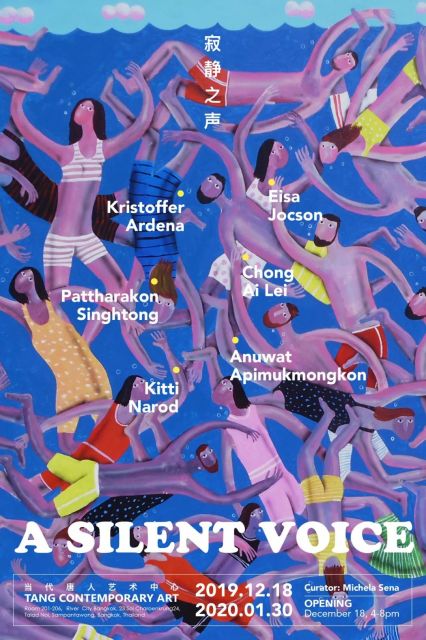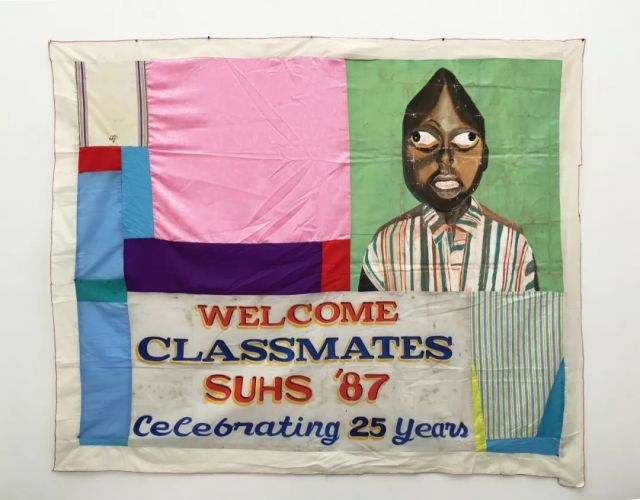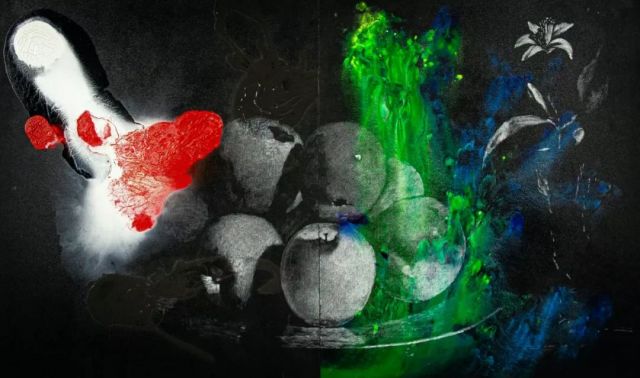
Tang Contemporary Art Bangkok proudly presents a group show with works by artists from Southeast Asia. The exhibition offers a distinctive glance by six outstanding artists, providing the transformation and recent developments of new emerging talented artists originating from different parts of the world. Nowadays, media is available to anyone in a democratic way, people from all walks of life can not only access media as a recipient of messages, but can also directly transmit messages to the rest of the world. “The media experience has become universal” (“Understanding Media”, McLuhan, 1964). Understanding the media, as McLuhan already observed in 1969, is the prerequisite for understanding the world.
This, more than a transformation, is a real revolution and the revolution affects art at the language level. Art language has dramatically evolved, in less than three decades we witnessed the transition from a multi-language and regional art world, toward a leveling of languages. The result is the birth of a common universal language: artists from different areas share a single aesthetic, and it is no longer necessary to refer to a socio-cultural context to decode a work.
There are no different aesthetics when aesthetic become unique and universal. As a result of this transition, art of any provenance speaks for itself and speaks to everyone. This new artistic language is a real common language that has definitely emancipated contemporary art scene from the cryptic linguistic babel of 30 years ago.
This exhibition gathers a new generation, who possess a general accent on an individual dimension. These six artists begin from personal experience, affirming the value of their perceptions and individual language. At last, the exhibition reveals private reflections and personal artistic visuals for viewers.
A Silent Voice
What does “East” mean today and what is “West”? Does it still make sense to consider and interpret society through this duality? Shouldn’t it be more appropriate to read today’s world as a whole made of different cultures with equal visibility and possibilities for contamination and dialogue? What has changed in the past 30 years? How has the world’s social and economic asset been transformed and how has art consequently changed?
It probably makes no sense to talk about “Asian art”, when we talk about Asian artists belonging to the latest generation. That’s because this generation of Asian artists is part of the global International scene and “artistically” they speak the same language as their peer artists of any other geographical origin.
For this reason, even if the artists exhibited in “A Silent Voice” all come from South East Asia, for reading their works, we shall refer to the linguistic aspect typical of this generation, rather than focusing on their geographic origins.
What has changed today as a result of the changing in the global economy? The big change doesn’t affect cultures, the transformation is about media. Today media is available to anyone in a democratic way, in any geographical area, in any country, any ethnic group, anybody, not only can access media as a recipient of messages, but can also directly transmit messages to the rest of the world. “The media experience has become universal” (“Understanding Media”, McLuhan, 1964). Understanding the media, as McLuhan already observed in 1969, is the prerequisite for understanding the world.
This, more than a transformation, is a real revolution and the revolution affects art at the language level. Art language has dramatically evolved, in less than three decades we witnessed the transition from a multi-language and regional art world, toward a leveling of languages. The result is the birth of a common universal language: artists from different areas share a single aesthetic, and it’s no longer necessary to refer to a socio-cultural context to decode a work, there are no more different aesthetics, and aesthetic now is a unique and universal aesthetic. As a result of this transition, now art of any provenance speaks for itself and speaks to everyone. This new artistic language is a real common language that has definitely emancipated contemporary art scene from the cryptic linguistic babel of 30 years ago.

Kristoffer Arde?a, Ghost painting, toldo category, Authority 2, 2016; mixed media, painting on textile
This shift from a local cryptic language to a universal aesthetic is evident in Kristoffer Arde?a’s ongoing experiments in painting. His research, under a conceptual point of view, focuses on the topic of “topicality within the Philippine context”. His process consists in a specific artistic working methodology that, establishing a relationship among various materials, affirms the need to relate to alternative and non-traditional materials that might directly express natural energy and ideas. His work results in a very aesthetic art, expressed through a totally international language, universally understandable. Despite the thematic, his works position themselves on a global platform and he is not identifiable as belonging to a specific local context.
During the globalized era we don’t need to apply the dualistic
confrontation model in an attempt to understand the relation between
different cultures from different contexts. We are already living the
changing and we use a new unique perspective for approaching any kind of
art, just naturally reading it. There’s no dialectic made by contrasts
and differences, there’s not a center and a periphery, the concept of
Western hegemony dominating cultures belonging to the rest of the world
is definitely overcome. With the vanishing of the Western versus
non-Western model, the concept of “otherness” itself has changed, the
idea of “the other” has lost any national connotations, and it’s
radically changed in its essence. We passed from identifying the concept
of “others” on the basis of cultural and national identity to a more
individual level. Today “others” means “everyone but me”. And in this
new balance,
where the belonging to a group lost importance and meaning, the concept
of “self” gets enhanced by this new strong relationship “me versus
anyone else”.
The evolution of the concept of “others” and consequently the enhancing of the concept of “self” has acquired a particular emphasis in Asia. Here the new value of “other” and “self” affects dramatically young artists perspectives, they no more refer to the community as the traditional recipient and subject of their messages and generally among young people the concept of “community” is losing its traditional connotation of predominance over the concept of “individual”. The way of expressing themes related to society has also changed. When artists talk and denounce issues related to society, they feel the indiscriminate need to do so and they just freely express themselves, regardless of the public consent. There’s no search for social approval and artists don`t wait for validation from the community.
In relation to this process, we observe an increasing sense of individual perspective. Individualism has never been predominant among Asian artists, and it becomes now the starting point of their perception. Individualism is the encouragement of society to define yourself independent of society. Individualism is the encouragement to have an internalized identity should not be confused with ego projection. In fact, the new Asian generation tends to be seen as very individualistic compared to the collectivist conformist mindset that marked earlier generations.
Young Asian artists are not afraid that abandoning alignment with collective values it will lead them to be ostracized. In every area today in Asia, young people express themselves in ways that would have been unthinkable even ten years ago. There is a wide range of opinions on all kinds of problems and there are groups of nonconformist subcultures.
Eisa Jocson’s research is connected with social issues but the way she externalizes it is unique, it is cryptic and deeply intrinsic in the aesthetic element to the point to become inseparable and indistinguishable from it.
She is one of the most outstanding artists emerged to international art scene in the last years. Through her dance performances she creates a complexity of messages where at the same time she unveils different aspects of the society: she relates to Philippine migrant workers who leave their country to work in the entertainment and service industries. She denounces body politics in the service and entertainment industry as seen through the unique socioeconomic lens of the Philippines. Her performances include pole dance, macho dance, and Disney’s Snow white ballets to create a unique dimension through sound, text, and movements. Jocson studies how the body moves and what conditions make it move, she uses the word ‘corponomy’ to describe the body as it adapts to different economic situations, as the relationship between marginalized communities and mass culture.
As said, this new focus on individuality, overcoming the old collective dimension, is due to social and economic change and to the consequent recent domination of media. The new strong perception of “self” is not only accompanied by the abandonment of the identification with a social group and by the awareness of conquering freedom of expression and self-confidence. This new perspective also leads the artist to focus on one’s inner dimension, one’s own intimacy, on an individual world that constitutes a micro cosmos isolated from everything that happens outside. The internalization of perceptions. Once again, also in regard to this process the media have played a fundamental role: the Internet has literally changed the way artists express themselves and the perception they have of themselves and of reality.

Phattharakon Singthong, Deeper in still life, 2019; Wax, pencil and acrylic on canvas
In the last years, young people of any geographical provenance, using the Internet as a vehicle of expression, had the opportunity to modify the way of communicating in a wider sense. They use internet as much more of an emotional engagement with their own identity. The Internet allows people to express themselves in a way they wouldn’t do in the real life, it’s virtual and it’s relatively anonymous and safe. And if not completely anonymous, surely the Internet constitutes a protective shell that distances those who express themselves from those who receive the message. On an emotional level, therefore, communication is greatly facilitated, it’s free from emotional implications that communication in person entails. The Internet guarantees a protection from dissenting and critical opinions, thus weakens the fear of rejection. Young people have become accustomed to expressing themselves safely without fearing the community’s disappointment. That is why, once again, the new media have been so important in this transformation.
If in general worldwide the Internet facilitated freedom of expression and the predominance of the individual against the judgment of the community, in Asia the effect of the Internet implies even more significant changes.
In a society where the freedom of expression is formally hindered, and where traditionally the community’s judgment and control were encouraged, where everything had to take place in broad daylight, the Internet, guaranteeing some anonymity, acts as a protective shield, where the stronger social condemnation from the outside is, the stronger the shield becomes. Thus people, expressing themselves on the internet, perceive the protection of a wall that separate themselves from the outside world. Of course, the thicker the wall, the greater the distance with what happens outside, the more intense the sense of intimacy, introspection, privacy and isolation.
Emblematic to understand this concept are Singhtong’s own words; in describing one of his latest projects he summarizes in a few lines his evolution over the years: “Twenty years ago I drew by studying figures, shapes, weights, lights and shadows, compositions, stories, and meanings. Ten years ago I drew by studying emotions, feelings, questioning, and searching for meaning of life. Two years ago until now, I have been drawing to learn, to understand myself and nature by true veracity.” Through experiencing the atmosphere of still life from different angles his latest project “Deeper in Still Life, World, and Life” investigate his own perception of reality, his most private dimension, a world that lives in absence of defined categories of time and space and is impossible to confine in words.
While worldwide, among the new generations, there is a general accent on the individual dimension, in Asia this process acquires a further depth, this individual world becomes secret and hermetic. The artist is no longer worried by the need to communicate, he doesn’t worry to create messages that move from inside to outside in an attempt of meeting the public, now is the public of art to be asked to take action. It’s up to the public to make the effort of approaching and meeting the work. Artist’s intimate world is a secret one and it doesn’t relate to anything which happens out of it. It’s just like if the artist is speaking with a silent voice. He doesn’t care about the effect his message would have on society, he is not after public’s approval, and his voice speaks for a confined, autistic world, where life takes place far from social categorizations.
Chong Ailei, Girl with Blue Skirt, 2017; Oil on canvas
This is just what happens in Chong Ailei’s imaginary world. In her paintings women are spied by a voyeuristic eye, caught in their intimate environment, they seem not aware or not interested to the world around them. The artist doesn’t please the viewer, her works are self-sufficient, and on the contrary it is up to the viewer to take action in approaching the work and creating a relation with it. “When I started painting, I thought about the comfort I experience when I am by myself or at home. The girl doesn’t necessarily always represent me as a person or an artist. I am not trying to portray a certain someone but rather certain situations,” she explains.
In the project: “When I See You Again”, Chong Ailei paintings scenario is her childhood home, the place where she grew up. Just like in a psychotherapy, she needs to go back to her childhood world, she paints objects and places that somehow live in her memories. Who knows how responding to reality they are? Who cares after all…. her world at the same time is so unreal but also so necessary and substantial to her. In “Girl With Blue Skirt” the woman escapes from our gaze by choking her head and looking down. That skirt, she says, was gifted to the artist by her mother.
The woman /artist is dressed in the same blue skirt in “Standing Behind A Curtain.” She is hidden behind a curtain at her parents’ home. This curtain was Chong’s favorite hiding place while as a child she was playing hide-and-seek with her siblings.
Michela Sena
02 December, 2019
About the exhibition
Dates: 12.18,2019 – 01.30, 2020
Venue: Tang Contemporary Art Bangkok
Courtesy of Tang Contemporary Art, for further information please visit www.tangcontemporary.com.





























